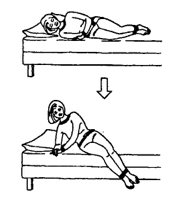
Post-operative therapy for a cervical fusion, discectomy, and laminectomy can start just days after surgery and should continue for at least 2-3 months. It will typically take anywhere from 5-8 months before the patient is cleared to engage in contact sports or other activities that may impact the neck. Anterior cervical discectomy and fusion is the most common surgery for neck pain. However, access to the spine can be achieved through incisions in the back, the sides, or a combination of approaches. Because of these variations, some exercises may not be appropriate for all patients. While the surgeon’s technique and the patient’s individual diagnosis will influence our clinical decision making, here is a general evidence-based guideline that we use at Back to Function for post-operative cervical spine rehabilitation.
Phase 1: (0-3 weeks)
Goals:
- Decrease pain and inflammation
- Encourage wound healing
- Increase activity tolerance
- Monitor for signs of possible infection
- Educate on body mechanics and posture for sleeping

Activities:
- Soft tissue therapy
- Increase tolerance to walking (½ mile daily)
- Diaphragmatic breathing
- Reinforce sitting, standing and ADL modifications with neutral spine and proper body mechanics
Precautions:
- Limit overhead arm movements, bending and lifting
- Follow physician recommendations regarding use of collars (multilevel fusions wear hard collar for 6 weeks; one-level fusions wear a collar as needed for 1-2 weeks)
- Prevent excessive initial mobility or stress on tissues
Phase 2: (4-7 weeks)
Goals:
- Protect fusion
- Decrease swelling
- Prevent stiffness/guarding
- Re-educate movement patterns/posture education
- Improve stabilization
- Increase activity tolerance/ improve positional tolerances for return to work (sitting/standing 30-45 min)
Activities:
- Soft tissue therapy
- Pain free active range of motion (AROM) cervical spine and upper extremities
- Diaphragmatic breathing: Proper breathing technique without the use of accessory respiratory muscles
- Upper thoracic mobilization exercises (cat/camel, thoracic extension, side lying rotation, all-4s with scapular integration
- Pelvic tilts
- Core & spinal stabilization exercises: donkey kick/opposite arm lift, fire hydrant/opposite arm, 2 leg Russian lift (neck supported if supine, neutral lumbar spine, *no bridging)
- Nerve glides as needed (*should not reproduce symptoms)
- Bike with proper posture
- Gentle isometrics (2 fingers)
Resisted Flexion
Stand or sit. Place your hand(s) on your forehead. Push your head forward against the heel of your hand without moving. Hold for a count of 10
(7 seconds). Relax. Repeat 3 times.
Resisted Extension
Stand or sit. Place your hand(s) behind your head – not your neck. Push your head backward against the palm of your hand(s) without moving. Hold for a count of 10 (7 seconds). Relax. Repeat 3 times.
Resisted Side-Bend
Stand or sit. Place your right hand on the right side of your face. Push your head sideways against your hand without moving your head. Hold for a count of 10
(7 seconds). Relax. Repeat in opposite direction with your left hand on your left temple. Hold for a count of 10 (7 seconds). Relax. Repeat sequence 3 times.
Precautions:
- Avoid excessive cervical loading (minimal overhead arm resisted movements)
- Limit lifting to 10-15 lbs
- Avoid passive stretching of cervical spine
Phase 3: (8-12 weeks after surgery)
Goals:
- Increase strength and flexibility
- Initiate balance activities
- Address return to work/recreational activity concerns
- Advanced stabilization and trunk control
Activities:
- Continue with above exercises and emphasize posture
- Manual therapy as needed
- Grade 1 or grade 2 joint mobilizations over restricted joints (above & below fusion)
- Occulomotor training and proprioceptive training: card catch, trampoline one leg ball catch
- Nerve glides (*do not reproduce symptoms)
- PRI exercises based on functional screen
- Work/activity specific training
- Isometrics with ball (flexion, extension, lateral flexion)
- Initiate advanced upper extremity strengthening: (cable diagonal lifts, TRX row, cable one-hand/opposite row, cable T’s, I’s)
- Continue upper thoracic mobilization exercises
- Advanced balance training exercises: bosu, rocker/wobble board
- Clear to initiate stretching of cervical spine if necessary
- Core: front and side elbow/push-up planks, plank progression, cable 2 hand rotation/chop
- Work/activity specific training
Phase 4: (Months 3-6+)
Goals:
- Establish prior level of functioning
- Safely return to full sport or exercise
Activities:
- Functional training exercises for sports or work specific activities
- Progressive weight training
- High impact / aerobic activity (jogging/running)
- May begin contact sports
This post-surgical rehabilitation protocol for cervical fusion, discectomy, and laminectomy has been adapted from the following sources cited below. It is not intended to be a substitute for clinical decision making regarding the patient’s own individual progression and/or the presence of post-operative complications.
If you have a neck issue that needs to be evaluated, please give us a call at (310) 534-1900 or email us at info@backtofunction.com
References:
Advanced Orthopedics and Sports Medicine. Post operative Spine Rehab-Cervical Fusion Treatment Guideline.
Curtis, Scott. Surgery For Neck Pain.
Orthopaedic Specialists of North Carolina. Cervical Fusion Post-Surgical Rehabilitation Protocol.
Southeast Georgia Health Center. Post-Surgical Rehabilitation Protocol: Cervical Laminectomy, Disectomy, Fusion.


